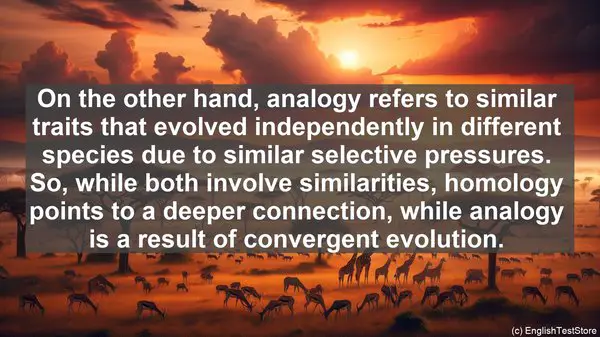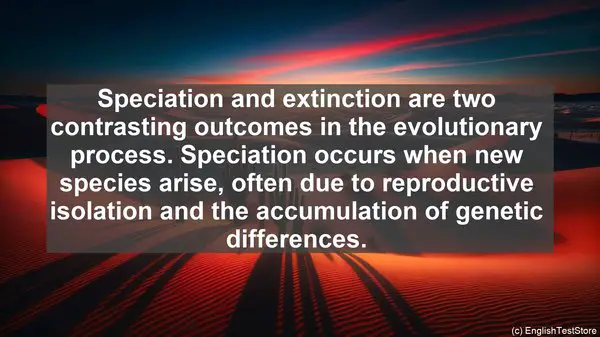Introduction
Today, we’re going to dive into the fascinating world of evolutionary biology. As you explore this field, you may come across some terms that seem similar but have distinct meanings. In this lesson, we’ll unravel the top 10 commonly confused words in evolutionary biology, ensuring you have a solid grasp of these fundamental concepts. Let’s get started!
1. Evolution vs. Natural Selection
While often used interchangeably, evolution and natural selection are not the same. Evolution refers to the gradual change in species over time, while natural selection is the mechanism driving this change. Natural selection acts on variations within a population, favoring traits that increase an organism’s chances of survival and reproduction. So, while evolution is the broader concept, natural selection is one of its key driving forces.
2. Homology vs. Analogy
When studying the similarities between species, it’s crucial to differentiate between homology and analogy. Homology refers to traits inherited from a common ancestor, indicating a shared evolutionary history. On the other hand, analogy refers to similar traits that evolved independently in different species due to similar selective pressures. So, while both involve similarities, homology points to a deeper connection, while analogy is a result of convergent evolution.

3. Microevolution vs. Macroevolution
Microevolution and macroevolution are terms used to describe different scales of evolutionary change. Microevolution focuses on small-scale changes within a population, such as the frequency of certain traits. Macroevolution, on the other hand, looks at larger-scale changes, such as the emergence of new species over time. While the mechanisms driving both may be similar, the scale of change is what sets them apart.
4. Gene vs. Allele
In the context of genetics, a gene refers to a specific segment of DNA that codes for a particular trait. Alleles, on the other hand, are different versions of a gene. For example, a gene may code for eye color, and different alleles of that gene could result in blue, green, or brown eyes. So, while a gene is the general term, alleles are the specific variations of that gene.
5. Convergent Evolution vs. Divergent Evolution
Convergent and divergent evolution are two patterns of evolutionary change. Convergent evolution occurs when unrelated species develop similar traits due to similar selective pressures. For example, the streamlined bodies of dolphins and sharks, despite their different evolutionary origins. Divergent evolution, on the other hand, is when related species evolve different traits, often due to occupying different ecological niches. Both patterns showcase the adaptability of organisms in response to their environment.
6. Mutation vs. Genetic Variation
Mutation and genetic variation are both sources of genetic diversity within a population. A mutation is a change in the DNA sequence, which can introduce new traits. Genetic variation, on the other hand, refers to the presence of different alleles in a population. While mutations are one way genetic variation arises, other factors like recombination during reproduction also contribute.
7. Vestigial Structures vs. Homologous Structures
Vestigial and homologous structures provide insights into an organism’s evolutionary history. Vestigial structures are remnants of traits that were functional in an ancestor but have lost their original purpose in the present-day organism. For example, the appendix in humans. Homologous structures, on the other hand, are similar structures in different species that indicate a shared ancestry. For instance, the pentadactyl limb seen in various vertebrates. While vestigial structures have reduced or no function, homologous structures often serve different purposes in different species.
8. Adaptation vs. Acclimation
Adaptation and acclimation are two ways organisms respond to their environment. Adaptation is a long-term, heritable change in response to selective pressures. It involves genetic changes that enhance an organism’s fitness. Acclimation, on the other hand, is a short-term, reversible response to environmental changes. For example, when a mammal grows a thicker fur coat in winter. While both are responses to the environment, adaptation is a more permanent solution.

9. Speciation vs. Extinction
Speciation and extinction are two contrasting outcomes in the evolutionary process. Speciation occurs when new species arise, often due to reproductive isolation and the accumulation of genetic differences. Extinction, on the other hand, is the complete disappearance of a species. While speciation leads to biodiversity, extinction can result in a loss of diversity and ecological imbalances.
10. Gene Flow vs. Genetic Drift
Gene flow and genetic drift are two mechanisms that can change the genetic makeup of a population. Gene flow occurs when individuals migrate between populations, bringing their genes with them. This can increase genetic diversity and reduce differences between populations. Genetic drift, on the other hand, is the random change in gene frequencies due to chance events. It’s more pronounced in small populations and can lead to the loss of certain alleles. So, while gene flow promotes genetic exchange, genetic drift can result in the divergence of populations.
